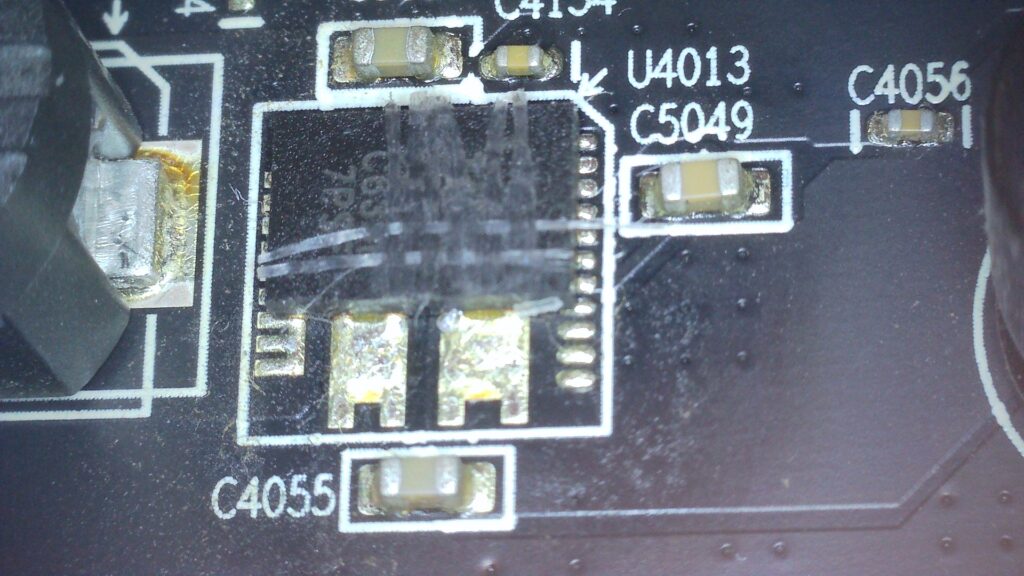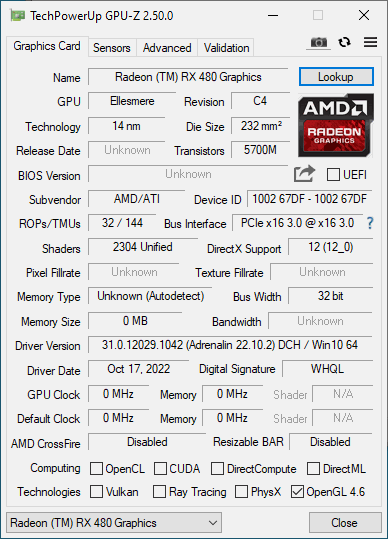Seller Note “LED’s light up and the fans spin but that’s it. No display. Died on me after 5 years of loyal service.”
Summary
- Was cheap, OK condition cosmetically, even has the box disk etc
- Resistances
- VCore – 0.9
- VMem – 28.8
- VDDCI – 21.5
- Display Rail – 28.7
- 1.8V – 4K
- 5V – 1.995
- 3.3V – 220.6
- 12V – K++ (PCI), 1.9 Short! (8pin EXT)
- Both fuses on the 8 pin PCI-EXT are blown
- OK, this matches with the seller’s description – Not detected, LEDs, but no fans
Investigating the short on 12V
The ESR readings for each phase show the U4013 as slightly lower.

Removing U4013 sees the 12V EXT rail’s resistance rise to 390. However, this still seems low for a 12V rail, so there is possibly another issue somewhere.
I want to test whether this card can safely take 12V, so I will:
- Inject 12 V (going up in stages) and check if any current passes and if so any warm areas – this seemed fine, the card took 12V injected without passing more than 0.1Amps. No voltage was detected on any phases.
- Replaced the two blown PCI-E fuses with new 10A fuses.
Power on testing:
- All voltages are present and seemingly stable.
- No picture as far as I could find on any ports.
- PEX reset seemed present.
- Haven’t checked the BIOS for signals yet.
- The card is detected (good).
- Both BIOS settings appear unreadable (no BIOS version, repeated device id in GPU-Z)

Next steps
- Try to reflash of the BIOS from windows (don’t have much hope of this working, but easy to try)
- Work out which chip is selected, check the BIOS is contacted from the core with an oscilloscope
- Possibly replace the BIOS chips with new ones.
- Possible the resistors to the BIOS are faulty.
As expected, the attempt to simply reflash the BIOS from windows didn’t work. Whilst it said it succeeded, the result was the same. Also, I spotted the same crazy sensor readings as on my other two faulty rx 480s, I am leaning towards a faulty core diagnosis now. This would fit with my earlier concern that 12V reached the core previously.
Hi! It’s me, from the 8th November 780 comments! I can’t comment there anymore, so here I am. The RTX 2080 Super I bought arrived, and here’s what I found out so far:
1. Before even plugging it in, I measured all rails I could access without opening the card (as it is still factory-sealed and I don’t have replacement thermal pads for now anyway). All resistances were fine. So…
2. I plugged it in my PC, not knowing what to expect. To my surprise, Windows started up fine, and everything seemed as if the card was fully functional! GPU-Z didn’t show any signs of a problem and I also ran some games, benchmarks, stress tests…very nice scores and until then, zero issues!
3. Then I made a MODS USB based on files from some German YouTuber. It uses DOS2Linux, and it doesn’t work very well (perhaps I just don’t know how to use it though). I could get MATS version 400 to function though. I ran a variety of tests, 5, 10, 25, 50, 100, even 200 Mb. No problem.
4. So I wanted to challenge the card…mining came to mind. And finally, after mining for a few minutes, the card froze up with “Space Invaders” artifacts (you can look it up on the internet to see how it looks). I was happy and sad at the same time…
5. After rebooting, the card seemed perfectly normal again. So I tried GpuMemTest, a Windows app for testing VRAM. The first time it ran, I got an error on one of the tests. Later when I ran it again, no errors. Third time a few hours later, no errors again.
What can I do in this kind of situation? The seller’s MATS report showed issues with FBIOA1, but I can’t replicate that myself. Is there any way to stress the card while doing MATS tests? Maybe then I can replicate it, when it’s heated…
Or perhaps I can run some MODS tests?
I really don’t know. I thought I’d just confirm the issue with MATS and go repair the card, but even though this really seems like a cold solder joint or bad VRAM, I would like to confirm the issue before tearing the card apart and reballing or whatever…
Any clue?
Hi, sure, I recognise you. Thanks for sharing that, things can see be a bit fairy tale sometimes, then the issue emerges. You would have to assume that if the guy had the knowledge test the VRAM with MATs then he would have fixed it if it was easy 🙂 Still, you’d feel robbed of a fix if it just worked right? I am less experienced with 20 series, but my quick thoughts are that the 3 dynamics to explore are:
1. Memory frequency -> MODS can sometimes find issues that MATs passes, definitely try it.
2. Heat -> Some people do indeed heat the card before testing e.g. from the back using a bit of hot air.
3. Twisting force -> when the card is tested is it horizontally mounted? This has caught me before, I now test all VRAM replaced cards for at least 1 week horizontally mounted without support in case the combination of heat and twisting causes the issue.
side from these aspects. Are you on the Learn Electronics Repair (LER) Discoord? (I am Rupo7 on there) It would be easier to chat there, plus there are much more experienced people than me for 20 series cards, so they can maybe help.
Thanks for the comment,
Rupert